General Information
| All of our books come as fully typeset, commercial quality productions, with a great deal of attention to detail. This is equally true for books on paper and for e-books (which we deliver as PDF's). | |
| E-books will generally be sent to you within two days by e-mail. Note that we are sometimes out of the office and that our office is open for normal hours, not around the clock or on weekends. Books on paper will be sent to you by mail using the best delivery method. | |
| When you click a purchase button, it will open a shopping basket. If you need more than one item, just come back to this page or go to any other page where products are for sale and click on another item. The shopping basket will appear with all items showing. When you are ready, make the purchase. | |
| Shipping costs for paper books: to purchase multiple books on paper, contact us with a list of the books you wish to purchase and we will send you a shopping basket by return e-mail with the correct shipping applied. This will reduce your shipment cost significantly. | |
| If you need further assistance, please use the please use the contact link on the menu to contact us. |
Special Feature: Tibetan texts
|
Our goal is to provide dharma books of the highest quality that give the greatest possible
access to the dharma materials involved. Therefore, many of our books have the relevant Tibetan text(s)
included. If not and you need the text, you can always ask for it and we will try to help. We also try to provide the Tibetan texts associated with each book as electronic files that can be read, searched, and used as part of an electronic Tibetan reference library. You can read about making an electronic reference library and obtaining the reader software needed • here. |
Titles in Print

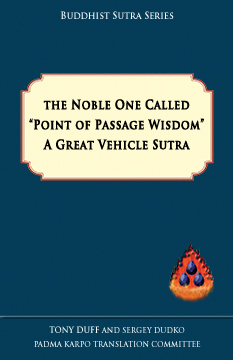
A Great Vehicle Sutra, with Other Emptiness explanations by Tony Duff
| Title | The Noble One Called "Point of Passage Wisdom", A Great Vehicle Sutra |
| Author | The Word of the Buddha from the Kangyur, translated by Tony Duff and Sergey Dudko |
| Details | 32 pages, 0 colour plates, 5.5" X 8.5", US$15, available in PDF and Kindle e-book formats |
| ISBN | paper book 978-9937-572-58-3, e-book 978-9937-572-59-0 |
| Texts | Tibetan text in Tibetan script |
This book contains a translation of an actual sutra of the Buddha. It is a very short but particularly important sutra from the Great Vehicle teachings given in the third turning of the wheel. The sutra is important for two reasons. Firstly, it is one of the five "condensed" sutras, sutras which sum up the five very large sutras of the Great Vehicle sutras—the Avatamsaka, and so on. This sutra sums up the meaning of the major sutra called The Nirvana Sutra in which the Buddha gives many final instructions before passing away. Therefore, it is regarded that the Point of Passage Wisdom sutra teaches final teachings of the Buddha in a very condensed way. This sutra is so important that the early Dharma Kings of Tibet recited it daily.
Secondly, this sutra is one of the ten sutras cited by the Other Empty (Zhantong) school in support of their position. These ten sutras are called the "Profound Meditation System" sutras by the Other Empty school because they are considered to convey the ultimate approach to view and meditation taught by the Buddha to his regent Maitreya. Of the ten sutras, this sutra, despite is very short length, is one of the most interesting. It gives, in an economy of words, a complete instruction on the view and meditation of the profound meditation system. In doing so, it explicitly shows the ultimate meaning of the third turning sutras and explicitly shows that the Other Empty or Zhantong approach is the ultimate intent of the Buddha. As a point of further interest, the seeds of Mahamudra and Dzogchen practice can be very clearly seen in this sutra and practitioners of those systems will also find it very interesting to see what the Buddha says about this.
All the pertinent threads of understanding are clearly brought out and tied together in a nice introduction by the author. Anyone interested in these matters will find this book to be essential reading. Amongst other things, it acts as a very nice, ultimate touch to our other books on Other Emptiness, such as Maitripa's Writings on the View and Mipham's Lion's Roar that Proclaims Other Emptiness. It is the ultimate touch because it is the word of the Buddha itself, the person who is the final arbiter of the view and meditation for Buddhists, and because his meaning is undeniable.
The book contains a translation of the following sutra:
 | The Noble One Called "Point of Passage Wisdom", A Great Vehicle Sutra |
Download Tibetan text in TibetD format: not available yet.
Purchase:

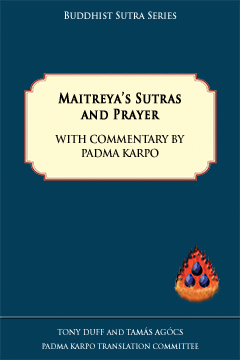
A sutra of the Buddha, commentary by Padma Karpo, and explanations by Tony Duff
| Title | Maitreya's Sutras and Prayer |
| Sub-Title | With Commentary by Padma Karpo |
| Author | Tony Duff and Tamas Agocs |
| Details | 208 pages, 0 colour plate, 6" X 9"(large format), US$25, available in PDF and Kindle e-book formats |
| ISBN | paper book 978-9937-572-62-0, e-book 978-9937-572-63-7 |
| Texts | Tibetan texts in Tibetan script included |
The Prayer of Maitreya, found in the forty-first chapter of the Ratnakuta Great Vehicle Sutra, is one of the five great prayers of the Great Vehicle tradition and, after Samantabhadra's Prayer, one of the most popular prayers for all followers of that tradition. It is recited every day without fail by many Tibetan followers and we think would be recited more often by non-Tibetans if they had access to a reliable translation with a clear explanation.
The prayer is approximately half the size of Samantabhadra's Prayer, though the content of the two prayers is sufficiently similar that learning about one considerably enhances an understanding of the other. Thus, this text of Maitreya's Prayer will be an excellent support for those trying to understand more of Samantabhadra's prayer and vice versa. Maitreya's Prayer is a little less complicated than Samantabhadra's Prayer and hence easier to understand and also easier to use as a prayer. Essentially, it consists of the seven limbs followed by an explanation of emptiness followed by explanations of the six paramitas.
In order to understand the prayer, it is necessary to read the sutra in which the prayer is first presented. Many think that the prayer was made by Maitreya, one of the heart sons of Buddha Shakyamuni. However, it was not—it was made by a former incarnation of Maitreya many aeons before Maitreya himself appeared. The Buddha himself recalled the prayer with his omniscience and presented it in an important sutra petitioned by Maitreya. The Buddha recalled it in order to show the difference between his own approach to enlightenment and the approach taken by Maitreya. Without reading these events in the sutra, it is not possible to understand the prayer, let alone correctly translate it. Therefore, the book contains a complete translation of that discourse, and to give the reader even more sense of the bodhisatva Maitreya and his works, includes a second sutra petitioned by Maitreya.
The prayer itself contains many prayers within its twenty-four verses, so a guide to it is needed. There are not many commentaries available, though a highly informative one by the great Drukpa Kagyu author Padma Karpo is very useful.
Thus, the book is a very rich collection of materials, containing two previously un-translated Great Vehicle sutras, plus the prayer of Maitreya, plus a major commentary to it. A long introduction clarifying all these materials is also included. Finally, all of the Tibetan sources are included in Tibetan script to assist translators and those studying the Tibetan language.
The book contains a translation of the following sutras and texts:
 | Of The Great Stack of Jewels's hundred thousand chapters of dharma enumerations, the forty first chapter, An Authoritative Statement Petitioned by Noble Maitreya |
 | Of The Great Stack of Jewels's hundred thousand chapters of dharma enumerations, the forty-second chapter, An Authoritative Statement Concerning Eight Dharmas Petitioned by Maitreya |
 | Maitreya's Prayer extracted from the forty-first chapter of the Stack of Jewels Sutra |
 | A Commentary to Noble One Maitreya's Prayer; Asanga's Understanding Clearly Shown by All-Knowing Padma Karpo |
Download Tibetan text in TibetD format: not available yet.
Purchase:


A third-turning sutra of the Buddha, with explanations by Tony Duff
| Title | The Sutra Petitioned by the Householder Uncouth |
| Sub-Title | A Teaching of the Buddha Showing All-Knowing Wisdom and the Householder's Way |
| Author | Tony Duff and Tamas Agocs |
| Details | 216 pages, 0 colour plates, 6" X 9" (large format), US$25, available in PDF and Kindle e-book formats |
| ISBN | paper book 978-9937-572-56-9, e-book 978-9937-572-57-6 |
| Texts | Tibetan text in Tibetan script included |
This book presents a Great Vehicle sutra of the third turning of the wheel of dharma which has not been translated until now and which is regarded as specially important for two reasons. Firstly the sutra deals with the issue of whether a bodhisatva can live a householder's life and effectively practice dharma at a high level. In the time when the Buddha gave this discourse it was regarded in Indian culture as a whole that it was necessary to leave the household and additionally to become ordained as a monk or nun in order to practice dharma at the highest level. The Buddha ends the sutra by saying that not only is it possible to practise whilst living as a householder but that a householder bodhisatva can be a much more capable and effective bodhisatva than a bodhisatva living the celibate life of an ordained bodhisatva.
The person who petitioned the Buddha for his authoritative statements on this matter was a householder bodhisatva named "Uncouth". His concerns, which are the main issues in the sutra, result in the sutra fitting very closely with the situation of today's Western Buddhists, most of whom do not wish to leave home and become mendicants and most of whom are equally determined that this should not mean that they are relegated to a life which has been officially stamped as lesser than that of an ordained life. These have become prominent issues for Western Buddhists at this time and a careful consideration of the actual meaning embodied in this sutra can be a very fruitful exercise for today's Western Buddhists. I have found that investigating the sutra carefully raises many issues of great relevance and interest to today's Western Buddhists, but more than that, the issues are raised in the environment of the Buddha giving his authoritative statements about them. We found it to be very provocative but very rich at the same time.
The sutra is very rich; it has many very interesting threads. Aside from the above, it has another very important feature, which is that it teaches non-dual wisdom at the highest level. It is one of the ten sutras which the Other Emptiness followers of Tibet marked out as the ten essential sutras of the third turning that show the Other Emptiness meaning. We have also translated another of those ten, which has the title "Point of Passage Wisdom Sutra". These two sutras are indispensable for those who are trying to understand the Other Emptiness teaching. A lot more could be said about this but it would take up too much space here. The book includes a long introduction which deals with the main themes of the household bodhisatva and Other Emptiness that appear in the sutra. The book contains a translation of the following sutra:
 | The nineteenth chapter of The Noble One, The Great Stack of Jewels' dharma enumerations in a hundred thousand chapters: The one Petitioned by the Householder Uncouth |
Download Tibetan text in TibetD format: not available yet.
Purchase:

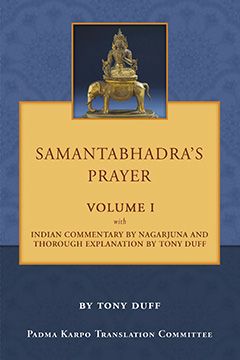

In-depth explanations of the prayer, supported by commentaries by Nagarjuna, Tenpa'i Wangchuk, Tony Duff, and others in two volumes
| Title | Samantabhadra's Prayer |
| Sub-Title | Volume I: The original sutra with prayer, the Indian commentary by Nagarjuna, and
the Western commentary by Tony Duff. Volume II: The original sutra with prayer and the Tibetan Commentary by Ontrul Tenpa'i Wangchuk |
| Author | Tony Duff |
| Details | Vol I: 298 pages, 2 colour plates, 6" X 9" (large format), US$30 Vol II: 224 pages, 1 colour plate, 6" X 9" (large format), US$25 |
| ISBN | Vol I: paper book 978-9937-572-60-6, e-book 978-9937-572-61-3
Vol II: paper book 978-9937-572-83-5, e-book 978-9937-572-82-8 |
| Texts | Tibetan texts in Tibetan script not included |
The Prayer of Samantabhadra, also known as "a prayer of excellent conduct" and also as "a king of prayers" is one of the five great prayers of the Great Vehicle tradition and one of the most popular prayers in that tradition—for example, it is recited every day without fail by many Tibetans. While using the prayer in Tibetan and English, the author discovered that existing English translations from Tibetan sources have many mistakes, all of which give readers a wrong understanding of what the prayer actually says. Worse, translations into other languages such as German and Russian from the mistaken English translations have carried all the mistakes along with them. Therefore, the author undertook a major study of the sutra in order to provide practitioners with a reliable translation and a complete set of explanations that would explain correctly and in depth every facet of meaning contained of the sutra.
Firstly, the prayer was not composed as a prayer. It is actually a set of verses that were spoken by the bodhisatva Samantabhadra to summarize an amazing teaching he had just given to a young bodhisatva. The teaching was on the subject of the excellent conduct of a bodhisatva. The teaching and the verses were later recorded in one of the Great Vehicle sutras. Later still, the verses were extracted from the sutra and written out alone for ease of recitation. An unfortunate consequence of that has been that many people have mistakenly thought that the verses actually were composed as a discrete prayer, and so have lost the all-important connection to the actual teaching given in the sutra. To rectify this problem and make the fullness of the prayer available to English-speaking practitioners, the author went on to make a translation of the entire sutra and its concluding verses.
However, still more was needed because there is an enormous amount of meaning hidden in the words of the verses, meaning that cannot be seen let alone understood without assistance. Therefore, the author assembled everything needed to explain every facet of meaning of every word in the verses and published all of the work in two full volumes detailing the prayer. The two volumes share a very extensive introduction that clarifies the nature of the prayer. Following that, they share a translation of the entire sutra, including the verses. After that, each volume presents its own commentaries in order to show the meaning of the verses.
Volume I has two commentaries, one by the Indian master Nagarjuna and one written by the author himself. It is essential to have an Indian commentary as a basis for understanding and translating the prayer because it will show the original understanding of the prayer according to the Indian tradition of Buddhism. Several such commentaries are preserved in the Tibetan Translated Treatises and the author read them all. He selected the one by Nagarjuna because it is the earliest of all the preserved Indian commentaries and also because it is particularly clear, showing points of meaning and grammar that are essential to obtaining a correct translation of the prayer. Likewise, it is essential to have a commentary written by an English-speaking expert so that all the issues related to the prayer in English translation can be clearly presented for readers. For this commentary, the author drew together material from many Indian and Tibetan commentaries then explained the prayer directly in English, paying special attention to English-related issues that are not covered in Indian or Tibetan commentaries.
Volume II is taken up with a single, very large Tibetan commentary. There are a number of commentaries by Tibetan masters. Unfortunately, for several centuries these masters have explained the verses in ways that do not agree with the explanations of the Indian commentaries. In fact, the Tibetan system of explanation of the prayer has been corrupt for several centuries, an issue which is explained in detail in the introduction to each volume. Nevertheless, the Tibetan commentaries have much to offer, so one was chosen for this second volume. The author of the chosen commentary was Ontrul Tenpa'i Wangchuk, who was regarded as one of the greatest living scholars and Dzogchen masters in Tibet until his recent passage. His commentary is regarded as very useful because it goes through the verses word by word, in a level of detail not seen in any of the other Tibetan commentaries. More than that, it is unique amongst all of the Indian and Tibetan commentaries in that it was not given as a scholarly exploration of the meaning of the verses but was given as practical advice to his lay disciples on how to follow the excellent conduct of a bodhisatva. Therefore, his commentary is particularly useful for anyone wanting to use the prayer not only for recitation but as a basis for developing himself as a bodhisatva.
Volume I contains translations of the following texts:
 | The teaching of Samantabhadra given to Sudhana, concluded with Samantabhadra's Prayer, recorded in the Avatamsaka Sutra |
 | Samantabhadra's Prayer Together with Explanation by Noble One Nagarjuna |
 | A Thorough Explanation of Samantabhadra's Prayer by Tony Duff |
Volume II contains translations of the following texts:
 | The teaching of Samantabhadra given to Sudhana, concluded with Samantabhadra's Prayer, recorded in the Avatamsaka Sutra |
 | "The Enlightenment Highway", A Commentary to the Excellent Conduct Prayer, Or Notes of This and That Remembered, Written as Practical Instructions for Men and Women Householders Encouraging them to Virtue by Ontrul Tenpa'i Wangchuk |
Download Tibetan texts in TibetD format: not available yet.
Purchase:

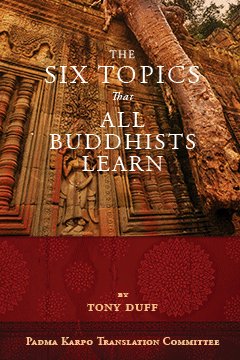
Text by the Great Khenpo Zhan-ga of Dzogchen Monastery, explanations by Tony Duff
| Title | The Six Topics That All Buddhists Learn |
| Sub-Title | A Text by the Great Khenpo Zhan-ga of Dzogchen Shri Singha College |
| Author | Tony Duff |
| Other | Zhanphen Chokyi Nangwa |
| Details | 222 pages, 1 colour plate, 6" X 9" (large format), US$25, available in paper format |
| ISBN | paper book 978-9937-572-13-2, e-book 978-9937-572-12-5 |
| Texts | Tibetan text in Tibetan script included |
The Buddha himself said in a Lesser Vehicle sutra:
"Son of the family! You are to become expert in the skandhas. You are to become expert in the āyatanas. You are to become expert in the dhātus. You are to become expert in pratītyasaṃutpāda. You are to become expert in topics. You are to become expert in non-topics."With these words, the Buddha indicated that there are six topics which must be learned, at least to some extent, by every one of his followers. Although the Buddha gave these teachings in the Lesser Vehicle, they are a necessary foundation for practitioners of all levels, from those studying the Lesser Vehicle to those practising Mahamudra and Great Completion.
This book gives a thorough explanation of the six topics using a text written by Zhanphen Chokyi Nangwa, or Khenchen Zhan-ga as he is more commonly known, the greatest of all abbots to have presided over the famous Shri Singha monastic college at Dzogchen Monastery, Tibet. The author of the book, the well-known teacher and translator Tony Duff, supplements the explanations in the text with many clarifications in an extensive introduction.
The text is very similar to Mipham Namgyal’s famous “mkhas ’jug” or Gateway to Knowledge as it has been called. Unfortunately, Mipham’s text is difficult for beginners. Zhan-ga’s text is quite different; it was not written merely as a piece of scholarship, but was carefully composed so as not to exclude beginners with excessively difficult explanations and moreover to be helpful to practitioners of all levels. For these reasons, Gangteng Tulku has selected our book rather than Mipham's Gateway of Knowledge in order to teach this topic to students in the second year of his shedra.
The book begins with an explanation of all six topics that everyone should learn, then proceeds to explain the details of the Great Vehicle according to Mind Only, then according to the Middle Way, and finally according to Great Completion.
The text itself is a product of a very glorious period in East Tibet when Jigmey Lingpa and his main disciples were transmitting the innermost, unsurpassed Quintessence Great Completion teachings received in visions of Longchen Rabjam. Following that, there was a period of scholars of astounding levels of knowledge who also attained very high realization through the Longchen Nyingthig system of teachings that was being freshly transmitted. Thus, this text is not just another text on scholarly matters but is fully connected with the flourishing of the exceptionally profound Great Completion or Dzogchen teachings at Dzogchen and other nearby monasteries. The connection of the text to that period is clearly explained, with short biographies of the main people involved—Zhanphen Thaye, Orgyan Tenzin Norbu, and Zhanphen Chokyi Nangwa—included.
Extensive explanations of the meaning of the six topics are provided by the author from his own knowledge gathered during forty years of studying with the Gelug, Kagyu, and Nyingma traditions, not to mention his extensive stays at Dzogchen Monastery where he learned the approach of Zhan-ga directly from Zhan-ga's successors. Ample footnotes, an extensive glossary, and a carefully corrected edition of the Tibetan text are also provided. An effort has been made to make the book amenable to those who would like to study the English translation and the Tibetan text together.
The book contains a translation of the following text:
 | "A Mirror Revealing Knowables", A Teaching on the Six Topics in which One is to Become Expert by Khenchen Zhanphen Chokyi Nangwa |
Download Tibetan text in TibetD format: not available yet.
Purchase:

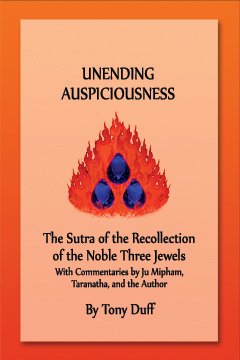
The sutra, in-depth explanations of it, and extensive commentaries by Ju Mipham, Taranatha, and Tony Duff
| Title | Unending Auspiciousness |
| Sub-Title | The Sutra of the Recollection of the Noble Three Jewels with Commentaries by Ju Mipham, Taranatha, and Tony Duff |
| Author | Tony Duff |
| Details | 306 pages, 2 colour plates, 6" X 9" (large format), US$30, available on paper and in PDF and Kindle e-book formats |
| ISBN | paper book 978-9937-838-61-0, e-book 978-9937-572-54-5 |
| Texts | Tibetan text in Tibetan script: Derge edition of the extended recollections of the Three Jewels, and Sutra of the Recollection of the Noble Three Jewels |
The Sutra of the Recollection of the Noble Three Jewels is a compilation of the Buddha's teachings called "the recollections". The recollections are widely used throughout all Buddhist traditions as a way of remembering the Three Jewels and deepening faith in them. This book is a particularly complete collection of everything needed to study, practice, and even translate the Sutra.
The book starts with three chapters of introduction which explain: the origins of the Sutra; the many translation issues raised by the Sutra; and how to study and practise the Sutra. These chapters contain a wealth of material gathered and arranged in one place by the author after years of study of the Sutra. They contain something for everyone. There are discussions of faith and how to arouse it using the Sutra. There are extensive discussions of translation which are a must-read for anyone doing translation work from Tibetan Buddhist texts; they cover important issues of translation that have not been seen in print to date. Then there is helpful guidance on how to study and understand the Sutra. There is also a section on how to access the magic of fundamental reality using the Sutra.
 Read a preview of the book's
Read a preview of the book'ssecond introductory chapter
The chapter in the preview text contains ground-breaking explanations of the translation process that was followed in Tibet and the process that needs to be established for translating Tibetan texts into English and other languages. Clearly, it will be of great interest to almost anyone seriously involved with Tibetan studies. However, the chapter also contains in-depth explanations of the meanings of terms such as buddha, Three Jewels, arhat, and so on and should be of wide interest, even to non-scholars. It is of such interest that we are providing it for free as an independent document.
The body of the book follows. It starts with all of the source materials needed to understand, study, and translate the Sutra (see below for the list of texts included). The sources are backed with information on them and how they relate to the Sutra in the first introductory chapter. Following that, the Sutra itself in Tibetan and English is provided. The book culminates in three major commentaries to the Sutra.
The first commentary, by the author himself, was written directly in English to make it easy for English speakers to understand all the details of the Sutra and the many issues surrounding it. At the same time, it is very extensive, covering issues that even the Tibetan commentaries do not consider. For example, the author presents a number of insights taught by the vidyadhara Chogyam Trungpa when he explained the Sutra in 1982 but which seem to have been lost. It also gathers into one place the many issues surrounding the Sutra raised by the two Tibetan commentaries. The second commentary, by the extremely learned Tibetan Taranatha, has the advantage of being a shorter commentary that it is relatively to understand. The third commentary is the very extensive and rather complicated one by Ju Mipham Namgyal that has become very famous in general these days as the way to study the Sutra. Mipham's commentary is very technical and can be hard to understand in places unless one is already very well versed in Buddhist philosophy. Therefore, the author has provided extensive notes to make it accessible.
The administration of Gangteng Tulku's shedra for his Western students has reviewed our book and the translation of Mipham's commentary in particular and called it "superb". They are strongly recommending it for all the shedra students.
The book contains translations of the following texts:
 | The recollections of buddha, dharma, and sangha as originally taught by the Buddha, in Pali, Sanskrit, and English |
 | The recollections of buddha, dharma, and sangha as extended by Great Vehicle followers, from the Derge edition of the Tibetan Tangyur, in Tibetan |
 | The Sutra of the Recollection of the Noble Three Jewels, edition from Dudjom Jigdral Yeshe Dorje's Collected Works, in Tibetan and English |
 | A Complete Commentary to The Sutra of the Recollection of the Noble Three Jewels by Tony Duff, in English |
 | A Little Explanation of The Sutra of the Recollection of the Noble Three Jewels by Taranatha, in English |
 | A Complete Commentary to The Sutra of the Recollection of the Noble Three Jewels called "A Melody of Unending Auspiciousness" by Ju Mipham Namgyal, in English |
Purchase:


Padma Karpo's explanations of Shantideva's Entering the Bodhisatva Conduct, book by Tony Duff
| Title | A Bitwise Commentary on Entering the Conduct |
| Sub-Title | "A Lamp for the Path of the Middle Way" |
| Author | Text by Drukchen Padma Karpo, book and translation by Tony Duff |
| Details | 150 pages, 5.5" X 8.5", US$20, available in PDF and Kindle e-book formats |
| ISBN | paper book not assigned, e-book 978-9937-572-66-8 |
| Texts | Tibetan text not included |
The Bodhisatvacayavatara or Entering the Bodhisatva's Conduct by Shantideva is one of the favourite books for followers of Tibetan Buddhism. And its popularity has spread far beyond that because it presents a completely selfless view of how to live one's life, which many have found very inspiring. Therefore, several translations of it have been made into English and other languages.
Shantideva wrote his text in very beautiful but very terse verse, often making it hard for the reader to understand exactly what he was saying. To solve this problem, Indan and Tibetan masters wrote commentaries to clarify its meaning. Many of them are long and hard to read, so have not been translated for Westerners.
However, there is a very nice commentary by the great Tibetan author Padma Karpo, which takes the approach of inserting sufficient words into the text that its meaning becomes is clarified while not adding so many words that they detract from the original. This type of commentary is called a bitwise commentary because it takes the words of the text bit by bit, adding a word or some short commentary here and there as needed to clarify the text. In this way, Padma Karpo gives us a particularly useful guide to Shantideva's work, one that is useful to scholars but especially useful to the average person who would simply like to understand this brilliant piece of work better.
 Read a preview of the book
Read a preview of the bookShantideva's work was written in Sanskrit verse, which usually does not go easily into Tibetan (and the same is true of English). Padma Karpo, knowing this, did not try to render Shantideva's work in verse but turned it into prose. The prose form with clarifying words included reveals a new dimension of meaning in the prayer that is not gained from reading the existing translations of the text.
Padma Karpo's commentary is long, therefore, we are publishing the work in a number of volumes. The first volume to be published contains the first four chapters of Shantideva's text in a new translation together with Padma Karpo's clarifying commentary.
One of the special features of Padma Karpo's commentary s that it gives a very long commentary to the especially famous ninth chapter, the chapter on prajna. This part of the commentary is particularly useful for practitioners wanting to study the Madhyamaka or Middle Way teachings. Padma Karpo explains the ninth chapter is explained according to the Kagyu-Nyingma understanding, which has been called the Other Emptiness approach. (This chapter is not available in the current volume. Unfortunately, it will be some time before the remaining chapters are translated. However, the work as it stands is substantial and will greatly assist an understanding of these first four chapters.)
The book contains a partial translation of the following text:
 | A Bitwise Commentary on Entering the Conduct, "A Lamp for the Path of the Middle Way" by the fourth Drukchen, All-Knowing Padma Karpo |
Purchase:

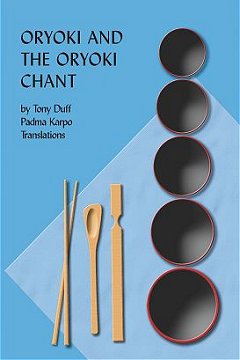
Book by Tony Duff
| Title | Oryoki and the Oryoki Chant |
| Author | Tony Duff |
| Details | 146 pages, 5.5" X 8.5", US$20, available on paper and in PDF and Kindle e-book formats |
| ISBN | paper book 978-9937-903-10-3, e-book 978-9937-572-49-1 |
| Texts | Tibetan text in Tibetan script: meal liturgy and sutra included |
Oryoki is the Japanese way of turning meals into meditation practice. The Vidyadhara Chogyam Trungpa Rinpoche introduced it to his Shambhala community of Western Buddhists in 1980. He adapted it slightly, putting a Tibetan monastic meal liturgy with it. Accordingly, the book starts with a history of Oryoki going from its beginnings in the East through its early development in the West under the guidance of the Vidyadhara. Following that, the book explains the meaning of the whole liturgy, step by step so that every part of it can be understood and applied to the practice of eating.
Recommended additional reading: Unending Auspiciousness, The Sutra of the Recollection of the Noble Three Jewels with Commentaries by Ju Mipham, Taranatha, and Tony Duff.
The book was originally written to provide a full explanation of Oryoki practice for members of the Shambhala community. And the Shambhala Office of Practice and Study has encouraged the book's use within the Shambhala community given the author's extensive knowledge of Oryoki and his first hand experience of the Vidyadhara's teaching of it at several seminaries.
However, as the book took form, the author was asked by members of various other Buddhist communities to write about the practice in way that would give them access to the practice too. The result is a book that could easily be used as a starting point for any Buddhist practitioner or group, Tibetan or otherwise, wanting to make meals into meditation practice.
The monastic meal liturgy translated and explained in the book is a standard liturgy for the purpose compiled by Dudjom Rinpoche. The book will be of specific interest to followers of his tradition, too.
The liturgy begins with a sutra called "Sutra of the Recollection of the Noble Three Jewels". The Buddha gave the teaching in the sutra for the use of all of his disciples. It is the means for developing faith and strength of refuge in the Three Jewels. This sutra is so fundamental to Buddhist practice that it is used in one form or another in all schools of Buddhism. The author has translated the sutra, together with the rest of the liturgy, and has also written an extensive commentary to it that should be of great value to every Buddhist, quite aside from the rest of the book. Some Tibetan commentaries on the sutra can be hard to understand because of the technical detail that they go into. The author wrote his commentary specifically so that the sutra is fully explained but in a way that anyone could understood it.
The book contains translations of the following texts:
 | The monastic liturgy for meals as arranged by Dudjom Rinpoche |
 | The Sutra of the Recollection of the Noble Three Jewels |
Purchase:

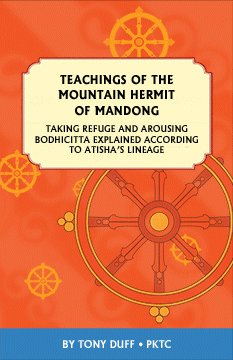
Taking Refuge and Arousing Bodhichitta Explained According to Atisha's Lineage, book by Tony Duff
| Title | Teachings of the Mountain Hermit of Mandong |
| Sub-title | Taking Refuge and Arousing Bodhichitta Explained According to Atisha's Lineage |
| Author | Translations and introduction by Tony Duff |
| Details | 148 pages, 5.5" X 8.5", US$20, available on paper and in PDF and Kindle e-book formats |
| ISBN | paper book 978-9937-903-18-9, e-book 978-9937-572-48-4 |
| Texts | Tibetan texts in Tibetan script not included |
This book contains two teachings, one on taking refuge in the Three Jewels and one on the development of bodhichitta or enlightenment mind. The teachings are translations of two texts from the Collected Works of the Hermit of Mandong. The hermit was a Kagyu master who lived in caves in the Mandong area of Tibet during the latter half of the 20th century, after the Communist Chinese invasion. He is not known to most Westerners but is quite famous amongst Tibetans these days. Why? Well, he was very learned and highly accomplished, but, over and above that, he was famous for his love and compassion for the very impoverished people of his area. In the darkness following the Chinese destruction of Tibet, he went out of his way to ensure that the poor and downtrodden people of his area not only received Buddhist teachings but received teachings from the heart that they really could understand and practice. The two teachings in this book are texts written specifically to assist those people and are very potent because of it. The compassion of the Hermit of Mandong comes through very clearly.
The Hermit was a follower of the Kagyu lineage, a lineage that gained the complete Kadampa teachings on refuge and bodhicitta as taught by Atisha through the early Kagyu master Gampopa. The two teachings here come from that tradition. Because of the Hermit's ways explained above, the teachings are not dry expositions at all, but are very heartfelt and wonderful to read. Moreover, they contain many stories and quotes from the early Kadampa masters and from Kagyu masters such as Milarepa, Karmapa, and so on. What is really fascinating about both teachings is that they were given for a thoroughly traditional audience, so they talk about hell realms and so on in a traditional way. However, the teachings are intensely personal and practical, so they go from what could be teachings that many Westerners would not find relevant to being thought-provoking teachings on love and compassion. This feature on top of all the other features of the teachings makes this a very interesting book.
Books like this tend to be overlooked these days because these days people are forgetting about refuge and bodhicitta and seeking only the hot topic of Dzogchen. Refuge and bodhicitta are indispensable for all according to the Buddha, and this little book brings those two teachings right to the fore in a very compelling way.
The book contains translations of the following texts:
 | From the Stages of the Path to Enlightenment: A small instruction on Taking Refuge called "The Great Entrance to the Excellent House of the Conqueror's Precious Teaching" |
 | From the Stages of the Path to Enlightenment: For Beginners in the Great Vehicle, The Method of Meditating on Compassion that References Sentient Beings called "An Ornament for the Minds of Young Conquerors&lsquo Sons" |
 • free Tibetan texts page, as a complete
source of teachings on refuge and bodhichitta that follows Atisha's style of explanation.
• free Tibetan texts page, as a complete
source of teachings on refuge and bodhichitta that follows Atisha's style of explanation.Purchase:


Padmasambhava's autobiography translated by Tony Duff
| Title | The Condensed Chronicle by Orgyan Padma |
| Author | Translation and introduction by Tony Duff |
| Details | 38 pages, 1 colour plate, 5.5" X 8.5", US$15, available on paper and in PDF e-book format |
| ISBN | paper book 978-9937-824-40-8, e-book 978-9937-572-18-7 |
| Texts | Tibetan texts in Tibetan script not included |
Padmasambhava himself gave two verbal accounts of his life and who he was. One is a very long exposition, known simply as the Chronicles of Padma. The other is a much shorter version of the same, known as The Condensed Chronicle by Orgyab Padma.
The condensed version was told by Padmasambhava as a story to King Mutri Tsanpo, son of King Trisong Deutsen, at the King's request. Padmasambhava recounts in his unique style who he is, his life story, practices, and accomplishments. Then, at a further request of the king, Padmasambhava makes many predictions into the far future. The predictions are interesting because many of them are about past events and every prediction can be seen to have been exactly correct. Padmasambhava commanded that his story should be recorded and hidden as treasure. That was done and the record of it was revealed much later on; the details are also included in the text.
The book is a translation of the text with introduction and some notes as necessary to clarify certain parts of the text. The events around the work of translation were quite interesting. The work was done during a major set of empowerments given at Zhechen monastery in 2005. Zhadeu Thrulzhig Rinpoche, who was giving the empowerments, introduced the reading of the entire text as part of the daily prayers for the entire assembly. He explained that reading it out loud once a day or even once a month, etcetera, had profound power to avert obstacles and problems and bring auspiciousness. At the time there was no translation in English and the large Western contingent was unable to do the practice. Therefore, I did the translation the next day, printed it, and offered it to the Westerners who were pleased to be able to join in. On its presentation, Thrulzhig Rinpoche was especially pleased, and there were unusual signs in the environment that showed the dakinis likewise were very pleased!
Download Tibetan text in TibetD format: • available here. Note that the electronic edition is not the same as the one used for the translation. The one used for the translation is from the original revealed treasure, the one provided here had been incorporated in the New Termas of Chogling and was extracted from that. There are slight differences between the two editions; the original edition is slightly better.
Purchase:

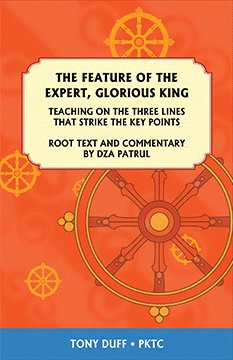
Teaching on the Three Lines That Strike the Key Points, root text and auto-commentary by Dza Patrul, book by Tony Duff
| Title | The Feature of the Expert, Glorious King |
| Sub-title | Teaching on the Three Lines That Strike the Key Points, Root Text and Commentary by Dza Patrul |
| Author | Translations and extensive introduction by Tony Duff |
| Details | 108 pages, 1 colour plate, 5.5" X 8.5", US$20, available on paper and in PDF e-book format |
| ISBN | paper book 978-9937-824-43-9, e-book 978-9937-572-23-1 |
| Texts | Tibetan texts in Tibetan script included |
The first Patrul Rinpoche is one of the important lineage holders of the Longchen Nyingthig transmission of innermost Great Completion (Dzogpa Chenpo). He wrote many texts on Great Completion practices. One of them has become particularly famous as a manual for the practice of Thorough Cut (Thregcho). It is treasured for its particularly clear and complete explanation of the practice from the very beginning all the way to the very end of the practice. These days, it is the text most commonly used to explain the practice
The actual title of this text is "The Feature of the Expert, Glorious King". The Expert, Glorious King is Patrul's description of himself as someone who has the lineage and means to provide this explanation of one of the most profound practices of dharma. The lineage of innermost Dzogchen has several root teachings on Thorough Cut practice and all of them can be used as a basis for a manual of how to practice Thorough Cut. One of the most popular ones is a teaching that came from Garab Dorje after he had passed away. This teaching was given as a set of three lines of instructions to his disciple Manjushrimitra and is generally known as the "Three Lines". Patrul's text is actually an explanation of the Three Lines teaching from Garab Dorje. Patrul used the three lines as a basis and then expanded on them so that their meaning could be more easily understood. For that reason, the text has become known as The Three Lines that Strike the Key Points. It is so commonly called by this name that many people do not know the actual name of the text.
There are a number of translations of the text floating around but all of them are lacking in various ways. One of biggest problems with these translations is that most of them were made by translators who were not fully familiar with the material. The result is that most translations make major mistakes in the translation and all of them miss out on the subtleties of meaning involved. Proof of this is contained in the fact that most of them even mistranslate the title, not understanding its words or their significance! Because of this Tsoknyi Rinpoche asked Tony, who had already heard, practised, translated, and explained this text and the teachings on Thorough Cut in general for many years, to make a very careful translation of the text.
Patrul Rinpoche not only wrote this text but wrote his own, short commentary to it as well. The commentary certainly will help anyone to understand the very terse words of the original text. Therefore this book contains translations both of the root text and Patrul's own commentary to it. The book also includes an introduction that tells more about the text, notes and a glossary that provide significant help with the unique terminology involved, and an explanation of what the title actually says!
Download Tibetan text in TibetD format: • available here.
Purchase:

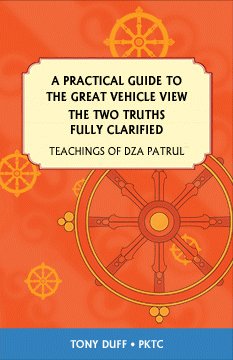
Text by Dza Patrul, book by Tony Duff
| Title | A Practical Guide to the Great Vehicle View, the Two Truths Fully Clarified |
| Sub-Title | Teachings of Dza Patrul |
| Author | Translation and introduction by Tony Duff |
| Details | 86 pages, 5.5" X 8.5", US$20, available on paper and in PDF and Kindle e-book formats |
| ISBN | paper book 978-9937-572-76-7, e-book 978-9937-572-75-0 |
| Texts | Tibetan text in Tibetan script included |
This book contains practical instructions on the view of the two truths given according to the conventional or common Great Vehicle approach. The instructions are contained in a short text by a very well-known Tibetan teacher, Jigmey Chokyi Wangpo, also known as Dza Patrul [1808–1887].
A feature of this text is that, although it is about sutra, the profound Dzogchen perspective is obviously present. Some masters write compositions in which they keep within the immediate context of their subject. Yogins, and Dza Patrul was a great yogin, often teach a subject but within the context of their own realization. In the text here, Dza Patrul gives a presentation of the two truths that fits with the sutra presentation of the subject, but goes on to connect it to the practical wisdom teachings of the third turning of the wheel and the Quintessence Dzogchen teachings of which he was a master. For example, in a presentation of the two truths that adhered to the sutra context in which the two truths were originally taught, there would be no mention of the key Dzogchen terms “rigpa”, “crossing over into”, “appearances of the liveliness”, and so on, yet these terms appear later in the text. In fact, the final section of teaching in the text is a direct presentation of the Thorough Cut teaching of Quintessence Dzogchen which has been skilfully added to the rest of the compilation to show that, in the end, the practice of the two truths is none other than the practice of Thorough Cut.
Those two features of this text make it very interesting to practitioners in general and Dzogchen practitioners in particular. Rather than being another one of the very dry presentations on the two truths that have appeared in Tibetan literature—such as in the literature of the scholarly Gelugpa tradition—this text is a very practical presentation of the two truths and how to realize them. The text becomes an avenue through which we can connect directly to Dza Patrul and his mastery of the sutras and tantras as well as his profound connection to Quintessence Dzogchen.
The book contains a translation of the following text:
 | A Practical Guide to the Great Vehicle View, the Two Truths Clarified by Dza Patrul |
Download Tibetan text in TibetD format: not available yet.
Purchase:

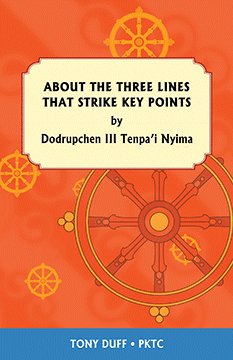
An Explanation of Thorough Cut With Direct Crossing woven in by Dodrupchen III, Tenpa'i Nyima, book by Tony Duff
| Title | About The Three Lines That Strike Key Points |
| Sub-title | An Explanation of Thorough Cut With Direct Crossing Woven In by Dodrupchen III, Tenpa'i Nyima |
| Author | Translation and introduction by Tony Duff |
| Details | 126 pages, 1 colour plate, 5.5" X 8.5", US$35, available on paper and in PDF e-book format |
| ISBN | paper book 978-9937-824-44-6, e-book 978-9937-572-53-8 |
| Texts | Tibetan text in Tibetan script included |
The Dodrupchens are well-known as one of the main holders of the Longchen Nyingthig lineage. The first Dodrupchen, Jigmey Thrinley Ozer, was a direct disciple of Jigmey Lingpa. After spending many years with Jigmey Lingpa, he returned to East Tibet and established a monastery at Dodrupchen. The third Dodrupchen declared that he would write extensively as a way to provide support for transmission of the lineage. Later, he was known especially for his writings in support of the system.
The text here contains a teaching given when he was quite young and shows the extent to which he understood the depths of the system even at that early age. He was asked to give some clarification of Garab Dorje's Three Lines teaching and this text is the result. This text of the Dodrupchen's is particularly interesting because it was not included in the original Collected Works of this Dodrupchen but was discovered much later and included only in recent editions of the Collected Works.
The Three Lines teaching is one of the main ways that Dzogchen view is transmitted these days. The Three Lines teaching is essentially a teaching on Thorough Cut. This can be clearly seen from Patrul's explanation of the teaching in his text called Feature of the Glorious, Expert King. In fact, Patrul's text is a pithy presentation of the way that the Dzogchen lineage transmits the meaning of Garab Dorje's Three Lines.
Dodrupchen's explanation of the Three Lines Teaching is particularly interesting because, as he himself says, the teaching does not follow the time-honoured style of explanation of Garab Dorje's teaching. It is clear from reading the text that Dodrupchen was explaining the subject from his own realization. This makes the text a particularly interesting complement to a text like Patrul's Feature of the Expert, Glorious King and we would strongly recommend that the two be read in conjunction with each other. Moreover, Dodrupchen's explanations cover important points that are not covered or not clearly covered in Patrul's text. It is for these various reasons that Lama Tony felt that this text should be translated and added to PKTC's collection of texts made specifically for the sake of Dzogchen practitioners.
One of the features of the transmission of Dzogchen in Tibet, as Lama Tony has experienced it personally, is that the teaching of Thorough Cut is never really divorced from the teaching of Direct Crossing (thogal). Therefore, it is no surprise that Dodrupchen does not stop merely with an explanation of Thorough Cut in this book but continues by showing how it connects to Direct Crossing and then gives a short teaching on the main points of Direct Crossing. This text complements the other text of Tenpa'i Nyima that we have translated, Condensed Advice on Great Completion.
The book contains the Dodrupchen's text in English. It includes extensive notes from Lama Tony to clarify difficult points in the text, a complete glossary to help clarify the meaning of the unique terminology of the system, and the Tibetan text as well.
Download Tibetan text in TibetD format: not available yet.
Purchase:

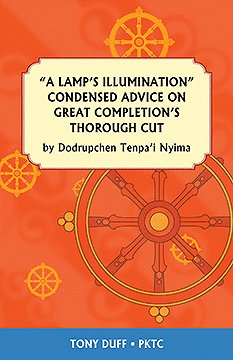
Text by Dodrupchen III, Tenpa'i Nyima, book by Tony Duff
| Title | Condensed Advice on Great Completion's Thorough Cut |
| Sub-title | "A Lamp's Illumination" by Dodrupchen III, Tenpa'i Nyima |
| Author | Translation and introduction by Tony Duff |
| Details | 74 pages, 5.5" X 8.5", US$20, available on paper and in PDF e-book format |
| ISBN | paper book 978-9937-572-69-9, e-book 978-9937-572-70-5 |
| Texts | Tibetan text in Tibetan script included |
The Dodrupchens are well-known as one of the main holders of the Longchen Nyingthig lineage. The first Dodrupchen, Jigmey Thrinley Ozer, was a direct disciple of Jigmey Lingpa. After spending many years with Jigmey Lingpa, he returned to East Tibet and established a monastery at Dodrupchen. The third Dodrupchen declared that he would write extensively as a way to provide support for transmission of the lineage. Later, he was known especially for his writings in support of the system.
The text here comes from the Collected Works of Tenpa'i Nyima. It is brief but covers many of the key points needed by a practitioner of Thorough Cut. Dodrupchen weaves an excellent story of the Thorough Cut teaching which has a beautiful flow to it. Some points will be impossible to understand without having a great deal of knowledge not only of Thorough Cut but also of many facets of Buddhadharma. Therefore, the author of the book has provided copious notes where they are needed so that anyone will be able to follow what the Dodrupchen is saying. For example, he weaves a very interesting story of self- and other-emptiness in relation to Thorough Cut which the author unravels for the reader. The text complements the other text of Tenpa'i Nyima that we have translated, About The Three Lines That Strike Key Points. It also complements Patrul's Feature of the Expert, Glorious King and we would strongly recommend that the two be read in conjunction with each other.
The book contains the Dodrupchen's text in English. It includes extensive notes from the author to clarify difficult points in the text, a complete glossary to help clarify the meaning of the unique terminology of the system, and the Tibetan text as well.
Download Tibetan text in TibetD format: not available yet.
Purchase:

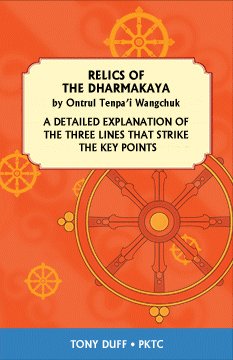
A detailed explanation of The Three Lines that Strike the Key Points by Ontrul Tenpa'i Wangchuk, book by Tony Duff
| Title | Relics of the Dharmakaya by Ontrul Tenpa'i Wangchuk |
| Sub-title | A Detailed Explanation of The Three Lines that Strike the Key Points |
| Author | Translation and introduction by Tony Duff |
| Details | 166 pages, 2 colour plates, 5.5" X 8.5", US$35, available on paper and in PDF e-book format |
| ISBN | paper book 978-9937-838-62-7, e-book 978-9937-572-52-1 |
| Texts | Tibetan text in Tibetan script included |
Ontrul Tenpa'i Wangchuk is regarded at the time of writing (2010) as the greatest living master cum scholar of Dzogchen in Tibet. His lineage is Longchen Nyingthig and he has written a number of commentaries on important texts of the system. His commentaries are very unusual; they show his extraordinary knowledge of the system and, magically, his realization is very easy to connect with while reading them. He is clearly a highly accomplished master.
Patrul Rinpoche wrote a small but especially important commentary to Garab Dorje's original "Three Lines that Strike the Key Points" teaching called Feature of the Expert, Glorious King. It is the most-used commentary these days on Thorough Cut within the Longchen Nyingthig lineage but needs explanation. There are a number of commentaries to it but they also tend to be short because they are intended as supports for oral instruction. This text is a commentary to Dza Patrul's text but is unusual in being very long and detailed. It explains every single word of the text step by step so that there can be no doubt over the meaning of the words in Dza Patrul's text. It is hard to emphasize how rare it is to be able to find an explanation as detailed and also as clear as this. In Lama Tony's mind, this is the very best commentary on the Three Lines teaching available. This is the first of Ontrul Tenpa'i Wangchuk's commentaries that we have translated though more are on the way.
For those who are practising Thorough Cut and also those interested in Longchen Nyingthig, these books naturally form a set: Dza Patrul's Feature of the Expert Glorious King text, Dodrupchen III's explanation About the Three Lines, and this explanation by Tenpa'i Wangchuk. Collectively, they give an excellent coverage of the Three Lines teaching. Also, the teaching by Dudjom Rinpoche called Alchemy of Accomplishment forms an excellent support for them. All of these texts are available just above.
Here is a review by a reader:
"I've just now completed Relics of the Dharmakaya, and was overjoyed at the clear and concise presentation. Well done! Things as explained are congruent with my experience, and it illuminates very well where one is in one's practice. The glossaries in this and PKTC's other books have been very helpful in my understanding, and I find the translations quite subtle."
Download Tibetan text in TibetD format: not available yet.
Purchase:


With texts of Jigmey Lingpa, Dilgo Khyentse, Longchen Nyingthig Root Tantra, the fourth empowerment sections of other tantras, and explanations by Tony Duff
| Title | Empowerment and Atiyoga |
| Author | Tony Duff |
| Details | 96 pages, 1 colour plate, 5.5" X 8.5", US$20, available on paper and in PDF e-book format |
| ISBN | paper book 978-9937-824-45-3, e-book 978-9937-572-21-7 |
| Texts | Tibetan texts in Tibetan script not included |
This book was composed to assist Western students who are taking empowerments in general. The book pays attention in particular to the meaning of the fourth empowerment, which itself is the direct meaning of Mahamudra and Maha Ati (Dzogpa Chenpo). It presents translations of the ritual texts used to give key empowerments in the Nyingma system and, especially, presents the root empowerment text of the Longchen Nyingthig cycle of innermost Dzogchen.
The book starts with an introduction that clearly explains empowerment. The introduction uses quotations from Padma Karpo's explanation of the Bodyless Dakini cycle of the Kagyu, which is the ultimate Dharmakaya practice given to Tailopa directly by Vajravarahi. Although this comes from the Mahamudra teachings, it is a teaching at the dharmakaya level, therefore it has the same meaning as innermost Dzogchen. The introduction continues by making particular reference to the Ati way of empowerment.
The book continues with the root empowerment text of the Longchen Nyingthig cycle, The King's Coronation Anointing Vase Empowerment. This text is from the root volumes of the Longchen Nyingthig Dzogchen transmission; anyone receiving the empowerments of the Longchen Nyingthig cycle will want the book just for this text. There are copious notes that explain the particular language of this empowerment and which show the unique approach of innermost Dzogchen in the process.
Following that text, the text for the fourth empowerment of The Narrow Fortress of the Eight Logos is presented. This is one of the central empowerments of the collected Kama empowerments of the Nyingma system. It shows the meaning of the fourth empowerment especially clearly and in Ati style. Again, there are copious notes to help bring out the meaning.
Once empowerment has been obtained, it is necessary to get the instructions on the practice and then to do the practice. Therefore, in order to make the book complete, the empowerment texts are followed by a teaching from Dilgo Khyentse Rinpoche on how to practice at this level. It was written as a letter to one of his Tibetan lady disciples. The letter contains a beautiful exposition of the Great Completion path, in purely practical style, and provides an excellent summary of the actual practice of the whole path of Thorough Cut.
The book overall consistently uses the unique language of Great Completion and the selection of texts shows how that language is used by the tradition when giving the empowerments and instructions on how to practice. Altogether, the book gives an overview of the path, all from an Ati perspective, in a way that notseen so far in the West. The commentary on empowerment was written entirely by Lama Tony Duff based on his years of experience with this particular dharma. All of the translations were done either during the empowerments themselves, for the sake of the other practitioners present, or, in the case of the final teaching, during the teachings on the letter given by Rabjam Rinpoche during the annual Zhechen seminar at Bodhgaya. The text carries the full weight of the blessings of the various empowerments and instructions that prompted the translations and ultimately, composition of the book.
The book contains translations of the following texts:
 | From Longchen Nyingthig: The Entire Text of the Root Empowerment, "The King's Coronation Anointing Vase Empowerment" |
 | From the Collected works of the Nyingma Kama Transmission: The Fourth Empowerment section of "The Narrow Fortress of the Eight Logos" |
 | From the Collected Works of the Nyingma Kama Transmission: The Suchness Empowerment Section of "The Six-Faced Yamantaka" |
 | Dilgo Khyentse's Advice To a Lady Disciple |
Purchase:

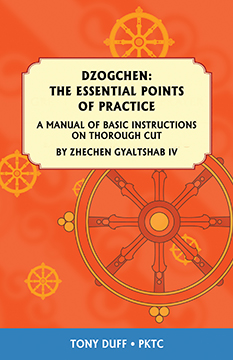
Text by Zhechen Gyaltshab, book by Tony Duff
| Title | Essential Points of Practice |
| Sub-title | A Manual of Basic Instructions on Thorough Cut by Zhechen Gyaltshab |
| Author | Translation and extensive introduction by Tony Duff |
| Details | 80 pages, 1 colour plate, 5.5" X 8.5", US$20, available on paper and in PDF e-book format |
| ISBN | paper book 978-9937-903-15-8, e-book 978-9937-572-22-4 |
| Texts | Tibetan texts in Tibetan script included |
Zhechen Gyaltshab was one of the principal masters of Zhechen Monastery in East Tibet, the monastery where Dilgo Khyentse Rinpoche made his home before leaving Tibet. The Zhechen Gyaltsabs have always been regarded as highly learned and accomplished and this comes through in the clarity of the instructions in his text.
The text is a short but very clear presentation of the essential points of practice of Thorough Cut (Tregcho) of innermost Great Completion (Dzogpa Chenpo). We provide many texts of the Thorough Cut practice and each one adds something to the understanding of that practice. Zhechen Gyaltsab's text transmits the same meaning as Patrul's Feature of the Expert, Glorious King which is also available from us. However and just as the title suggests, Zhechen Gyaltshab writes in a very practical way and in doing so, makes a number of points that other authors do not. His text is well-known in the Tibetan tradition as one of several texts that are particularly useful to anyone who is practising Thorough Cut.
An introduction explains the place of the text and extensive notes to the text form a commentary to the text. An extensive glossary is provided to help clarify the meaning of the unique terminology of this system. The book is ideal for anyone who is practising Thorough Cut. As with our other books on innermost Dzogchen, we strongly advise that you not purchase the book unless you have had the necessary instructions.
Download Tibetan text in TibetD format: • available here.
Purchase:

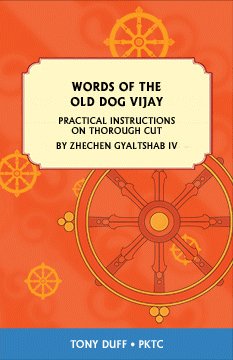
Text by Zhechen Gyaltshab IV, book by Tony Duff
| Title | Words of the Old Dog Vijay |
| Sub-title | Practical Instructions on Thorough Cut by Zhechen Gyaltshab IV |
| Author | Translation and introduction by Tony Duff |
| Details | 66 pages, 1 colour plate, 5.5" X 8.5", US$15, available on paper and in PDF e-book format |
| ISBN | paper book 978-9937-883-64-1, e-book 978-9937-572-55-2 |
| Texts | Tibetan texts (two teachings in one text) in Tibetan script included |
Zhechen Gyaltshab IV, Padma Namgyal, was one of the principal masters of Zhechen Monastery in East Tibet, the monastery where Dilgo Khyentse Rinpoche made his home before leaving Tibet. The Zhechen Gyaltsabs have always been regarded as highly learned and accomplished and this comes through in the clarity of the instructions in his text.
We provide many texts about Thorough Cut practice and this one adds something further. This text is very well-known in the Tibetan tradition as one of several texts that are particularly useful to anyone who is practising Thorough Cut of innermost Great Completion (Dzogpa Chenpo). The text consists of two short teachings of very practical instruction. Both teachings give a strong feeling of no-nonsense dharma and each one provides another take on the practice of Thorough Cut. For instance, the second teaching emphasizes the point of letting mind be as it is.
The book is ideal for anyone who is practising Thorough Cut. As with our other books on innermost Dzogchen, we strongly advise that you not purchase the book unless you have had the necessary instructions.
Download Tibetan text in TibetD format: • available here.
Purchase:

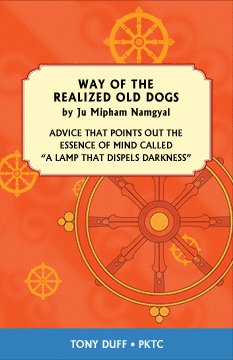
Text by Ju Mipham Namgyal, book by Tony Duff
| Title | The Way of the Realized Old Dogs, Advice that Points Out the Essence of Mind, called "A Lamp That Dispels Darkness" by Ju Mipham Namgyal |
| Author | Translation and commentary by Tony Duff |
| Details | 68 pages, 1 colour plate, 5.5" X 8.5", US$20, available on paper and in Kindle and PDF e-book format |
| ISBN | paper book 978-9937-824-42-2, e-book 978-9937-824-51-4 |
| Texts | Tibetan texts in Tibetan script included |
Ju Mipham Namgyal is one of the best known authors of the Nyingma tradition. He was a prolific writer with an extraordinary knowledge of his own and others' dharma traditions. He wrote several texts on the topics of innermost Great Completion (Dzogpa Chenpo). The one here is one of his texts on Thorough Cut (Tregcho). The wording of the title "Way of the Realized Old Dogs" is explained in the introduction by the author. Briefly though, it means that this is a text that lays out the way of practice of those who just practise the essence of their own minds and who develop realization that way. Through this, they eventually become realized in the system and wise to it; they become "Realized Old Dogs".
The text is a favourite of tantrikas, or, in Tibetan, ngagpas. It is a favourite for them because it is specifically for practitioners who do not live in a monastery or other dharma institution and who do not spend their lives developing a vast scholastic knowledge of Buddhism. In modern, Western terms, it is a text written specifically for the urban yogi.
As the text says,
"Without need of vast training in hearing and contemplating
The village tantrikas in general who preserve the essence of mind
Using the way of foremost instruction will go with little hardship
To the level of the vidyadharas; it has the power of a profound path."
The text is short but has become one of the core texts used in Tibet to teach Thorough Cut. Because
it is so popular within the Tibetan tradition and because it was specifically written for the urban yogi,
we felt that it was a worthy addition to our selection of texts on the subject of Thorough Cut. Therefore, we have
translated it and made a book out of it.The village tantrikas in general who preserve the essence of mind
Using the way of foremost instruction will go with little hardship
To the level of the vidyadharas; it has the power of a profound path."
As with each of our texts on Thorough Cut, this one has its own flavour and does emphasize certain aspects of the path. As it lays out the approach of the urban yogi, it has to present the introduction (often called pointing out) to the nature of mind. It does this in using what are called "differentiations". This is unusual because differentiations are usually transmitted orally from the teacher to the student and mostly are not written down. There are many differentiations; in this case Mipham sets out the differentiation between alaya and dharmakaya. The presence of this teaching is another reason for adding this to a library of teachings on Thorough Cut.
Download Tibetan text in TibetD format: not available yet.
Purchase:

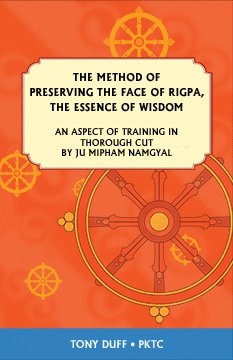
Text by Ju Mipham Namgyal, book by Tony Duff
| Title | The Method of Preserving the Face of Rigpa, The Essence of Wisdom |
| Sub-title | An Aspect of Training in Thorough Cut by Ju Mipham Namgyal |
| Author | Translation and commentary by Tony Duff |
| Details | 44 pages, 1 colour plate, 5.5" X 8.5", US$15, available on paper and in PDF e-book format |
| ISBN | paper book 978-9937-824-41-5, e-book 978-9937-572-47-7 |
| Texts | Tibetan texts in Tibetan script included |
Ju Mipham Namgyal is one of the best known authors of the Nyingma tradition. He was a prolific writer with an extraordinary knowledge of his own and others' dharma traditions. He wrote several texts on the topics of innermost Great Completion (Dzogpa Chenpo). The one here is one of his texts on Thorough Cut (Tregcho). The wording of the title "Preserving the Face of Rigpa" is explained in the introduction by the author. Briefly though, it is saying that this is a text that focusses on one specific aspect of Thorough Cut practice called "preserving rigpa". The remainder of the title, "The Essence of Wisdom", refers to the fact that this technique of preserving rigpa really is the essential technique for developing wisdom.
The text is short but has become one of the core texts used in Tibet to teach this specific aspect of Thorough Cut practice. Because it is so popular within the Tibetan tradition and because it is one of the few texts that deals specifically with this subject, we felt that it was a worthy addition to our selection of texts on the subject of Thorough Cut. Therefore, we have translated it and made a book out of it. Note that, although this text was written as part of Dzogchen instruction, it is equally applicable to the practice of essence Mahamudra. Thus the text is ideal for anyone who is practising either of the two. A short but clear introduction makes the content of the text accessible.
Download Tibetan text in TibetD format: not available yet.
Purchase:

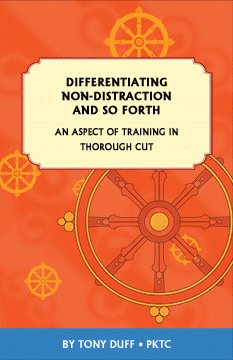
An aspect of training in Thorough Cut, book by Tony Duff
| Title | Differentiating Non-Distraction and So Forth |
| Sub-title | An Aspect of Training in Thorough Cut |
| Author | Translation and commentary by Tony Duff |
| Details | 42 pages, 1 colour plate, 5.5" X 8.5", US$15, available on paper and in PDF e-book format |
| ISBN | paper book 978-9937-903-12-7, e-book 978-9937-572-19-4 |
| Texts | Tibetan texts in Tibetan script included |
The author of this text is unknown but the text is regarded within Tibetan circles as one of a number of particularly useful texts that deal with specific aspects of innermost Great Completion (Dzogchen) practice. This text deals with the specific aspect of Thorough Cut (Thregcho) practice called "differentations".
The text is unusual in that "differentiations" are usually transmitted orally from the teacher to the student and mostly are not written down. There are many differentiations. The author of this text lays out three of the most important ones. He also adds some further oral instruction connected with the general practice of Thorough Cut. This is another important text to have in a library of teachings on Thorough Cut.
Note that, although this text was written as part of Dzogchen instruction, it is equally applicable to the practice of essence Mahamudra. Thus, the text is ideal for anyone who is practising either of the two. A short but clear introduction makes the content of the text accessible.
Download Tibetan text in TibetD format: not available yet.
Purchase:

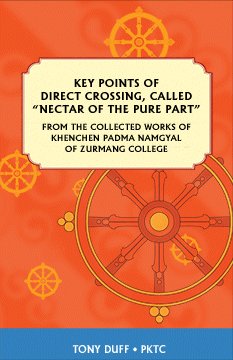
Text by Khenchen Padma Namgyal of Surmang, book by Tony Duff
| Title | Key Points of Direct Crossing, called "Nectar of the Pure Part" |
| Sub-title | From the Collected Works of Khenchen Padma Namgyal of Zurmang College |
| A text about Direct Crossing (thogal) practice | |
| Author | Translation and introduction by Tony Duff |
| Details | 44 pages, 1 colour plate, 5.5" X 8.5", US$25, available on paper and in PDF e-book format |
| ISBN | paper book 978-9937-903-11-0, e-book 978-9937-572-44-6 |
| Texts | Tibetan texts in Tibetan script included |
Khenchen Padma Namgyal was one of the great khenpos of Zurmang Monastery in Kham (Zurmang is the seat of the Trungpa Rinpoches). Khenchen Padma Namgyal travelled to Dzogchen monastery where he entered the famous Shri Singha College to gain a deep Buddhist education. He also learned the practices of Great Completion (Dzogpa Chenpo) while he was there. After completing his studies, he returned to Zurmang where he became renowned as a particularly knowledgeable khenpo who also had a deep practical understanding of innermost Great Completion practice.
One day, Khenchen Padma Namgyal had gone out onto a mountain side for a session of Direct Crossing (thogal) practice with his students. He started the session, as is usually done, with some instruction. The instruction turned into a summary of the whole practice of Direct Crossing. Lama Tony, while receiving these same instructions in places formerly visited by the Khenchen, was given the text. The auspicious connection was overwhelming so he translated the text immediately in the hope that it would be useful to others. The text is very short but the instruction is complete and will definitely be helpful to anyone who is genuinely doing Direct Crossing practice.
The book can be purchased by writing to Tony and asking for a copy. It will only be sold to those who are actually doing the practice and who do have proper instructions. Please present your credentials at that time. Needless to say, this kind of material is very hard to come by!
Download Tibetan text in TibetD format: not available yet.

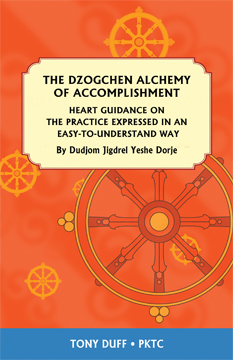
Text by Dudjom Rinpoche Jigdrel Yeshe Dorje, book by Tony Duff
| Title | Alchemy of Accomplishment |
| Sub-title | Instructions of Mountain Dharma, Heart Guidance on the Practice Expressed in an Easy-to-Understand Way by Dudjom Rinpoche Jigdrel Yeshe Dorje |
| Author | Translation and extensive introduction by Tony Duff |
| Details | 110 pages, 1 colour plate, 5.5" X 8.5", US$25, available on paper and in PDF e-book format |
| ISBN | paper book 978-9937-903-13-4, e-book 978-9937-572-15-6 |
| Texts | Tibetan texts in Tibetan script included |
Dudjom Rinpoche Jigdrel Yeshe Dorje was one of the great masters of the Nyingma tradition who lived during the 1900's. At one time, he was asked to give the basic instructions for Great Completion (Dzogpa Chenpo) practice to the members of a three year three month retreat that had just started. His discourse was recorded in writing and included in his Collected Works. The text of his discourse has become another of the several texts that have become very important for and are used frequently to present the teaching on Thorough Cut (Tregcho) of innermost Dzogchen. It has become popular not only in the Dudjom lineage but in Nyingma traditions in general because of its exceptionally clear and easy-to-understand explanation that comes right from the heart and goes straight to the heart.
The text contains full details of Thorough Cut practice explained in a way that is very easy to understand but which does not avoid any of the unique and beautiful technical language of the system. Here is a small quote from the book. It is what he says to the retreatants just after he has given the introduction (sometimes called pointing out instruction) to them:
"With that, we have made the mind of Samantabhadra blaze forth for us in direct perception and
what could be more enjoyable? This itself is the heart of the six million, four hundred thousand
tantras of Great Completion, which are the ultimate of all of the eighty-four thousand dharma
heaps distinguished by the Conqueror. There is no more celestial destination than this…"
The book starts with an introduction that gives the context for the text. It continues with
the translation which is fully footnoted and contains extensive explanations of the unique language
of this teaching. An extensive glossary is included so that even the technical language
can be fully understood. This text together with Patrul's Feature
of the Expert, Glorious King,
Dodrubchen's About the Three Lines, and
Zhechen Gyaltshab's Essential Points of Practice are
recommended as "must-read" texts for anyone doing any Great Completion practice and Thorough Cut practice
in particular.We found that the original edition of the text as found in Dudjom's Collected Works has many errors in it. Therefore, we made a new, correct edition that was checked by Gan Rinchen, the former head of Dudjom Rinpoche's centres in the United States. The new edition is included in the book for all concerned and is available as a free electronic edition from our site (see below).
Download Tibetan text in TibetD format: • available here.
Purchase:

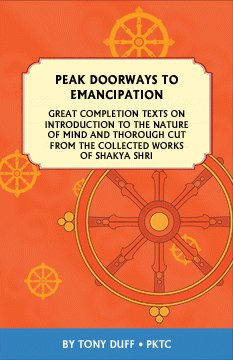
Texts by Shakya Shri, book by Tony Duff
| Title | Peak Doorways to Emancipation |
| Sub-title | Great Completion Texts on the Introduction to the Nature of Mind and Thorough Cut from the Collected Works of Shakya Shri |
| Author | Translations, extensive introduction, and commentarial notes by Tony Duff |
| Details | 104 pages, 1 colour plate, 5.5" X 8.5", US$20, available on paper and in PDF e-book format |
| ISBN | paper book 978-9937-903-19-6, e-book 978-9937-572-50-7 |
| Texts | Tibetan texts in Tibetan script included |
| New, highly expanded second edition. Published March, 2010 |
Shakya Shri was one of the greatest masters of the Drukpa Kagyu around the end of the nineteenth century. He was renowned for having practised and accomplished both the Mahamudra traditions of the Drukpa Kagyu and the Great Completion (Dzogpa Chenpo) tradition that had come to him through his root guru, Khamtrul Rinpoche. He taught students either Mahamudra or Great Completion or a mixture of both, whatever was suitable for them.
This book presents two texts from his Collected Works. Each one presents a specific aspect of innermost Dzogchen practice though the first text, on the introduction to the nature of mind, is fully applicable to essence Mahamudra, too. We chose the two texts because they highlight specific aspects of these practices that are not explained in any other texts available from us. As with several other texts on Thorough Cut, each text offers instruction on a key aspect of the teaching.
The first text is specifically on the topic of introduction to the nature of mind (sometimes called pointing out instruction). It is hard to find a text which, like this one does, specifically discusses this key technique of the higher tantras. The text will be of interest to anyone who is practising Mahamudra or Dzogpa Chenpo.
The second text continues by giving instruction on how to realize the nature of mind after it has been introduced to the disciple. This text specifically explains the practices of the Thorough Cut (Tregcho) of Great Completion. This text also includes specific instructions on the special preliminary practice of innermost Great Completion called Parting into Sides (Tibetan, rushen).
Both texts are very explicit and will be of real interest to anyone engaged in Mahamudra or Great Completion. The texts are Drukpa Kagyu so they will be of special interest to Drukpa Kagyu followers. The book includes a very complete introduction and extensive notes to help understand the texts.
The book contains translations of the following texts:
 | ""Opening the Door to Emancipation", A Very Abbreviated Uncommon Guide to Mind" |
 | "Thorough Cut's Secret Path, The Second Core Piece, Instruction on Nakedly Seeing Rigpa" |
Purchase:


The Drukpa Kagyu Mahamudra Preliminary Practices by Khamtrul III, Kunga Tenzin, book by Tony Duff
| Title | "The Complete Path for the Ocean of Profound Meaning", An Extensive Liturgy for the Visualization Procedures of the Mahamudra Preliminaries with a Listing of the Key Topics of the Main Practice |
| Sub-title | The Drukpa Kagyu Mahamudra Preliminary Practices by Khamtrul III, Kunga Tenzin |
| Author | Translation and introduction by Tony Duff |
| Details | 108 pages, 5.5" X 8.5", US$15, available on paper and in PDF e-book format |
| ISBN | paper book 978-9937-903-16-5, e-book 978-9937-572-17-0 |
| Texts | Tibetan texts in Tibetan script included |
There are a number of branches of the Drukpa Kagyu and each has it own liturgies for doing the preliminary practices (Tib. ngondro). The Kham (East Tibetan) tradition of the Drukpa Kagyu, headed by the Khamtrul Rinpoches has a number of these liturgies. However, the one composed by Kunga Tendzin, the third Khamtrul Rinpoche is the one most often used. It is the liturgy used for example at Tashi Jong in India, the present-day seat of Khamtrul Rinpoche.
The text of the liturgy was translated into English by Tony at the request of Tsoknyi Rinpoche. It is a standard, Mahamudra style preliminaries liturgy in which there are four sets of one hundred thousand preliminaries to be done. The liturgy is extensive. Kunga Tenzin included a lot of material in his liturgy and this makes it useful as a reference for anyone. For example, the whole laying aside practice done with the practice of The Thirty-five Buddhas, and the Sutra of the Three Heaps is contained in it. There is also a magnificent guru yoga section for the Drukpa Kagyu, which is exceptionally beautiful. There is also a nice collection of dedication prayers at the end.
The translation was done by Tony during a three-month session at Tsoknyi Rinpoche's Ngedon Osel Ling in Nepal, when a large group of Drukpa Kagyu lamas and rinpoches of the East Tibetan tradition gathered together for a Drukpa Kagyu Dharma Festival. The translation went very nicely and it was generally felt that the poetic qualities of the Tibetan came out well into English, which was pleasing to all concerned.
The liturgy should be of special interest to all Drukpa Kagyu followers. More than that, it should be of interest to anyone doing the preliminary practices.
Download Tibetan text in TibetD format: • available here.
Purchase:

Tsoknyi Rinpoche Books
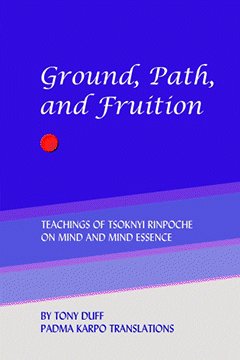
Teachings of Tsoknyi Rinpoche, translations and book by Tony Duff
 go here for details, purchase.
go here for details, purchase.

Teachings of Tsoknyi Rinpoche, translations and book by Tony Duff
 go here for details, purchase.
go here for details, purchase.

Yonge Mingyur Rinpoche Book

Teachings of Mingyur Rinpoche, translated by and book by Tony Duff
| Title | Meditator's Guide to Great Completion |
| Sub-title | Teachings of Mingyur Rinpoche |
| Author | Translation and short introduction by Tony Duff |
| Details | 280 pages, 6" X 9, US$35, available on paper and in PDF e-book format |
| ISBN | paper book 978-9937-572-73-6, e-book 978-9937-572-74-3 |
| Texts | No Tibetan texts included |
A complete set of teachings on the path of Great Completion as given by Mingyur Rinpoche. The teaching covers every topic, from beginning to end, for a person wanting to do the practice.
The book starts with an explanation of the truth of suffering and proceeds through the basic sutra teachings that have to be contemplated in order to re-orient the mind so that it turns away from cyclic existence towards enlightenment. The teachings here are simple but precise and very clear. The teaching then goes through the basics of the Vajra Vehicle: the preliminary practices, followed by the need for empowerment, followed by the practice of development stage. In these teachings, Mingyur Rinpoche gave and taught the practice of Vajrasatva, which is the most universal practice that works for the whole Vajra Vehicle. This practice is also closely tied to the teaching of Great Completion so it is very fitting. Each of the subjects involved is again taught very clearly and precisely. The teaching then spends considerable time on the practices of shamatha and vipashyana which are taught in a way that is consistent with the Parting Sides (Tib. rushen) practice of Great Completion. This part of the teaching is very extensive. It can be understood equally as the general practice of emptiness that is taught in the Great Vehicle as well as a particular precursor to the main practices of Great Completion. The teachings here correspond exactly to what Mingyur Rinpoche has set out as the first level of practice for all of his students. The teaching then proceeds to the main practice of Thorough Cut (Tregcho) of Great Completion. The teachings here are well set out and taught in a way that eliminates the doubts that people who have practised the Lesser Vehicle often have when confronted with these higher teachings. This style of teaching happened because most of the students in the audience were the students of Tsoknyi Rinpoche who had been practising the Vipassana system taught by Jack Kornfield and his group. The teachings here are not diluted but are taught in a way that clears away misconceptions about the practice. The book ends with various subjects related to the practice of Thorough Cut. The teaching does not include teachings on Direct Crossing (Tib. thod rgal).
This teaching was Rinpoche's first teaching in the West. It was given in California in 1998 with Tony as the translator. Tsoknyi Rinpoche asked Tony to go to translate for Mingyur Rinpoche because of Tony's many years of experience with the whole of the Buddhist teaching in general and particularly with translating Great Completion. Tony offered to make a book out of the teachings for Mingyur Rinpoche who was pleased with the idea. The book is unusually clear and complete because of the combined abilities of the teacher and translator.
Mingyur Rinpoche asked that the book be restricted because of the explicit teachings on Thorough Cut. It can be purchased from us by contacting us and indicating that you are qualified to receive the book. To qualify, you have to have heard Mingyur Rinpoche, Tsoknyi Rinpoche, Chokyi Nyima Rinpoche, or Tulku Ugyen's teachings on Thorough Cut or you have a letter or other proof of authorization from Mingyur Rinpoche himself. Those who have obtained complete instruction in Thorough Cut from another teacher can also apply.

Chogling Tesar and Tsoknyi Rinpoche Books

From Chogling Tersar, translations and introduction by Tony Duff
| Title | Kunzang Thugtig, Samantabhadra's Mind Essence; the Texts for the Practice of Thorough Cut and Direct Crossing (Thregcho and Thogal) |
| Author | Translations and introduction by Tony Duff |
| Details | 68 pages, 5.5" X 8.5", US$25, available in PDF e-book format |
| ISBN | |
| Texts | Tibetan texts in Tibetan script not included |
The Chogling Tersar (New Treasures of Choggyur Lingpa) contains a number of anthologies that come from the treasures revealed by Choggyur Lingpa and which contain everything needed for a complete practice from beginning to end of the Vajra Vehicle. One of the most profound anthologies is the one popularly called "Kunzang Thugthig" in Tibetan, Samantabhadra's Mind Essence.
Kunzang Thugtig contains everything needed for a complete practice of Great Completion. It has empowerments, texts, and oral instructions that provide everything needed to do a complete practice of both Thorough Cut (Tregcho) and Direct Crossing (Thogal). The book here contains two of the key texts of this system. The first is the revealed treasure of the anthology which sets out the entire path of Great Completion practice. It is a whole teaching in verse by Padmasambhava that shows the whole path of Great Completion starting from the ordinary preliminaries and going all the way through Parting into Sides, Thorough Cut, and Direct Crossing. It is a particularly beautiful work to read. The second is the main commentary that is used to clarify Guru Rinpoche's instructions in that revealed treasure. It is a commentary written by Karmey Khenpo who is one of the important figures connected with Choggyur Lingpa.
The two texts were translated at the request of Tsoknyi Rinpoche, who gave all the necessary empowerments and instructions to the translator, Tony. There was another translation available at the time but Tsoknyi Rinpoche felt it was not clear and asked Tony to make new translations of both texts saying specifically that a clearer and more accurate translations were needed.
You cannot purchase this text unless you have had the empowerments, instructions, and necessary transmissions from a qualified teacher; this will usually be someone in Tulku Ugyen's family such as Tulku Ugyen, Chokyi Nyima Rinpoche, Chogling Rinpoche, Tsoknyi Rinpoche, Mingyur Rinpoche, and so on. Alternatively, you must have had significant instruction in Thorough Cut and Direct Crossing. If you are in doubt DO NOT purchase the book but write to us first seeking permission to purchase.
If you have a special need for a paper edition of the text, please contact us first.
The book contains translations of the following texts:
 | The Treasure Revealed by Choggyur Lingpa: "From The Refined Gold of Great Completion, the Essence of Samantabhadra's Enlightened Mind: Wish-Fulfilling Jewel of a Guide to the Meaning, Whose Essence is the Self-Illuminating Mind" |
 | The Commentary by Karmey Khenpo: "A Profound Guide, Condensed yet Utterly Clear, to Supreme's Treasure, "The Essence of Samantabhadra's Enlightened Mind"" |


Translations, compositions, and explanations by Tony Duff
| Title | A Complete Manual for the Practice of Miyowa Trulkhor In Chogling Tersar |
| Author | Translations, compositions, and explanations by Tony Duff |
| Details | 40 pages, 5.5" X 8.5", US$125, available on paper and in PDF e-book format |
| ISBN | 978-9937-2-0224-4 |
| Texts | Tibetan texts in Tibetan script not included |
The Chogling Tersar (New Treasures of Choggyur Lingpa) contains a number of anthologies that come from the treasures revealed by Choggyur Lingpa and which contain the practices of Thrulkhor (postures) and Tsa lung thigle (channels, winds, and drops). These practices are at the completion stage with signs level. Of them, the Achala (Tib. miyowa) anthology is particular famous for its effectiveness. Lama Godi is a highly accomplished yogi of the system. At his request, Tony translated all of the necessary practice texts and, in addition, some commentaries made by earlier masters of the system. Lama Godi also asked Tony to write a complete commentary on how to do the preliminaries that go with the main practice. This commentary was also included in the book, together with a translation of the preliminaries text.
This text is available only to people who have specific permission from one of the senior people of the Chogling system; it can be Lama Godi, Chogling Rinpoche, Chokyi Nyima Rinpoche, Tsoknyi Rinpoche, Mingyur Rinpoche, etc. Contact Lama Tony by e-mail concerning this text.
Download Tibetan texts in TibetD format: not available.

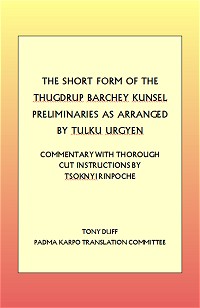
Teachings by Tsoknyi Rinpoche, translation and book by Tony Duff
| Title | Commentary on the Barchay Kunsel Condensed Preliminaries of the Chogling Tersar |
| Sub-title | Teachings by Tsoknyi Rinpoche |
| Author | Translated and compiled by Tony Duff |
| Details | 44 pages, 5.5" X 8.5", US$15, available in PDF e-book format |
| ISBN | 978-9937-2-0224-4 |
| Texts | Tibetan texts in Tibetan script not included |
The Chogling Tersar (New Treasures of Choggyur Lingpa) contains a number of anthologies that come from the treasures revealed by Choggyur Lingpa and which contain everything needed for a complete practice from beginning to end of the Vajra Vehicle. The one most practised these days is the one popularly called "Barchay Kunsel" in Tibetan, Total Dispeller of Obstacles. It has become very popular because the late Tulku Ugyen taught it extensively.
The Barchay Kunsel is a particularly large anthology and has several texts for doing the preliminary practices: long, middling, and short length forms. The late Tulku Ugyen, father of the current Tsikay Chogling Rinpoche was asked by his Western students to make an exceptionally short version of the already short version so that they could manage to do it in their busy Western lives. Tulku Ugyen accomodated their requests by writing a super-condensed version of the short length text. There was no official commentary on this super-condensed version until one day some students of Tsoknyi Rinpoche came and asked for an explanation of how to do it. At that time, Tsoknyi Rinpoche asked Tony to translate his explanation and additionally to produce a handbook for people wanting to practice it. Tsoknyi Rinpoche mentioned that his commentary was applicable to all versions of the Barchey Kunsel preliminaries, regardless of length.
The book starts with Tsoknyi Rinpoche's commentary. After that, there is a short introduction to the main practice to be done after the preliminaries are complete, the Great Completion (Tib. Dzogpa Chenpo) practice of the Thorough Cut (Tregcho). The short introduction is a teaching given by Tsoknyi Rinpoche to some of his students at around the same time.
Purchase:


Practice text by Tulku Ugyen with two commentaries by Tsoknyi Rinpoche, translations and book by Tony Duff
| Title | Tulku Ugyen's Guru Yoga and Commentaries on the Practice |
| Sub-title | Practice text by Tulku Ugyen with two commentaries by Tsoknyi Rinpoche |
| Author | Translated and compiled by Tony Duff |
| Details | 62 pages, 5.5" X 8.5", US$15, available in PDF e-book format |
| ISBN | |
| Texts | Tibetan texts in Tibetan script included |
The late Tulku Ugyen wrote a guru yoga for himself in 1980 at the request of one of his long-time students. The text is very short but exceptionally profound, incorporating all the elements of Great Completion (Tib. Dzogpa Chenpo) practice. The text became very important at the time of Tulku Ugyen's passing when it was practised very extensively by a large number of people. At that time, Tsoknyi Rinpoche gave a medium-length commentary on how to do the practice and just after that, a further commentary on the meaning of Thorough Cut.
The book includes the guru yoga in Tibetan script, in transliteration, and in translation to accomodate all needs. Both Tsoknyi Rinpoche's commentaries are included following that. The guru yoga sums up the path of Great Completion so there are many points in the commentary that will be interesting to practitioners of Great Completion in general, quite aside from their application to the guru yoga itself. The teaching on Thorough Cut will be of interest to all practitioners of Great Completion.
Purchase:
